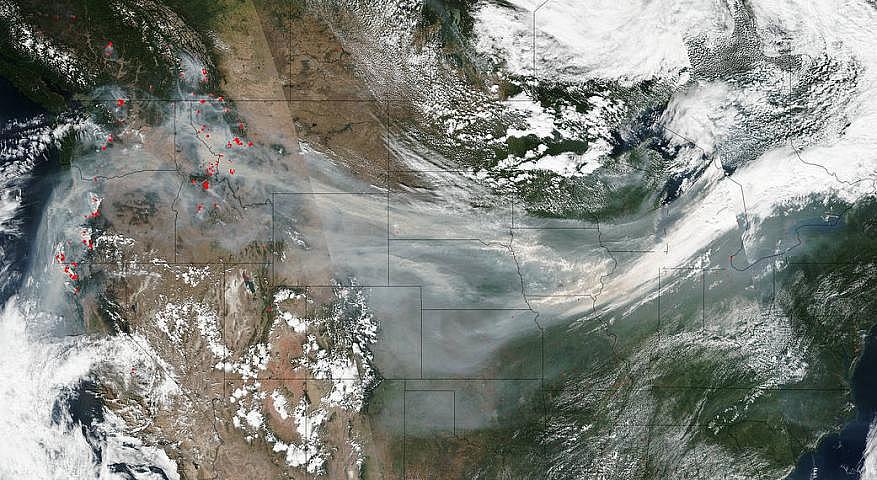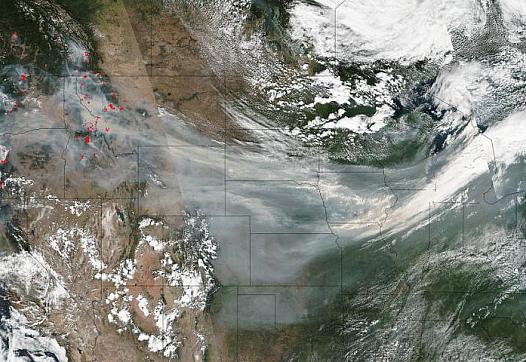Wildfires capture attention, but smoke remains the inescapable threat
The story was originally published in Northern California Public Media with support from our 2022 California Fellowship.

(Photo via Jeff Schmaltz/Flickr)
Wildfires are changing. With their new intensity and near year-round possibility, fires are remaking landscapes across the globe. From Siberia to Australia to right here in Sonoma County.
While wildfire can in most instances be escaped, its companion - smoke - is the part we can not so easily run from.
Producing hazy red skies, ash that swirls underfoot, and a burnt acrid flavor to the air, wildfire smoke can inundate areas dozens or even hundreds of miles from an active fire. The inescapable nature of wildfire smoke leaves those exposed susceptible to the destructive health effects, both acute and long-lasting, of smoke inhalation as noted by Tom Corringham.
"People who’re outdoors, engaged in strenuous activity during these wildfire smoke events are at significant risk."
Corringham is a researcher at Scripps Institution of Oceanography and is part of a Scripps team that studies health risks posed by wildfire smoke.
The researchers found that wildfire smoke, which like other smog and air pollution, is made up of fine particulate matter, poses an even more serious and severe risk to human health than similarly-sized air pollution.
"We looked at a number of different respiratory conditions that could be impacted by wildfire smoke, including upper respiratory tract infections, asthma, COPD." Corringham said. "And we found that all of these increased with exposure to wildfire smoke."
The main components of wildfire smoke are miniscule particles that measure under 2.5 microns, or less than one twentieth the width of a human hair. The detrimental effects come from their ability to lodge themselves within the deepest reaches of our lungs, even entering the bloodstream.
"At the population level this wildfire smoke increases hospital admissions for these respiratory conditions in a significant way that other forms of air pollution don't." Corringham said.
Those increased rates of hospitalization were found to have increased in certain instances by up to 10% when wildfire smoke was the main air pollutant as compared to other pollutants at similar concentrations.
Corringham said certain workers are particularly vulnerable to the detrimental effects.
"For farm workers, other folks who have to work outdoors, construction workers, for example, to the extent that people can stay indoors during these heavy smoke conditions they should do." Corringham said. "There is a trade off between the economic benefits from having people doing this work and the economic costs in terms of the health costs. And it's difficult to know how to balance that."
Most obviously vulnerable to working in hazardous and smoky conditions in Sonoma County: the large population of agricultural workers.
Estimates on the number of vineyard workers alone in Sonoma County range between 7,000 and 11,000 people. And their work under dangerous conditions and in close proximity to active fires is, as Michael Mendez, a professor of urban planning and public policy at UC Irvine noted - becoming even more common.
"Increasingly these wildfires in 2017, 2019 and 2020 collided with harvest season and much of the harvest of the wine grapes did not occur prior to the fire." Mendez said. "So these fires were happening between August and October, which is prime harvest season for this region."
Mendez has conducted research on the effects of climate change on the conditions of agricultural workers across California, including the safety of vineyard workers in Sonoma County during the LNU complex and Glass fires.
Mendez said his research into the working conditions of vineyard workers during the fires of 2020 aims to provide public awareness of the reality agricultural workers face as fires become more common.
"Many times they're just anecdotal stories that people don't really take too seriously." Mendez said. "So that's what was the intent of our policy brief is taking the own data from Sonoma County and really analyzing it to see those disparities and the burdens of, of disaster."
The main focus of Mendez’s investigation was Sonoma County’s Agricultural Pass system - operated on an ad hoc basis at the time of his research.
"We wanted to assess documents that Sonoma County had for what is called an agricultural pass, which enables employers, contractors, farm owners, to fill out a very simple two page application to request, to allow their farm workers and other essential workers to enter into these mandatory evacuation zones, to harvest the crops, or tend to other important activities on their properties." Mendez said.
He said the previously ad hoc system had resulted in a major lack of oversight.
"Our research shows that disproportionately hundreds of these farm workers and a majority of them undocumented farm workers were entering into these mandatory evacuation zones with lax government oversights." Mendez said. "There was really no follow up or understanding of how many people were actually going into these evacuation zones on a daily basis, their duration, and what sort of conditions they were experiencing out there in the job sites."
Corringham said there are simple and obvious steps to safeguard workers' health.
"The easiest solution that comes to my mind is ensuring that the people who do have to work outside have appropriate protective equipment." Corringham said. "So we're all familiar with N95 masks at this point, but they're not cheap, especially if you have to use a new one every day. So providing those to farm workers, for example, to construction workers, either free or at a discount, I think would be a possible policy solution here."
And Mendez said oversight is a must.
"Data accuracy and making sure there's checks and balances of this program." Mendez said. "That there's accounting and transparency; there's tracking of who's entering into these zones. And what are the occupational health and safety standards that are, are best for these workers?"
Data collection and protective equipment provisions have both been included in Sonoma County's official agricultural access pass program adopted late last month.
This is part one in a series from KRCB, in collaboration with the USC Annenberg Center for Health Journalism 2022 California Fellowship, looking into the harsh wildfire conditions agricultural workers in Sonoma County face.


